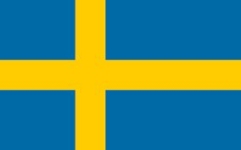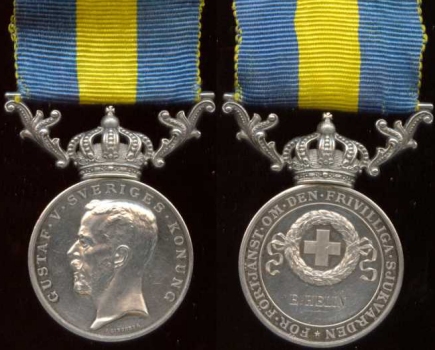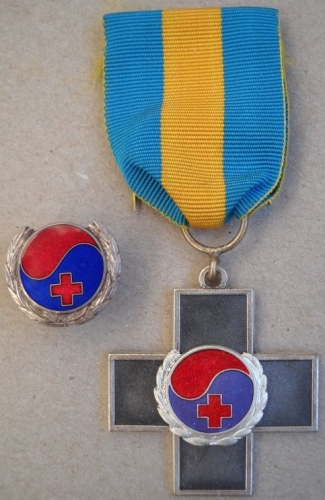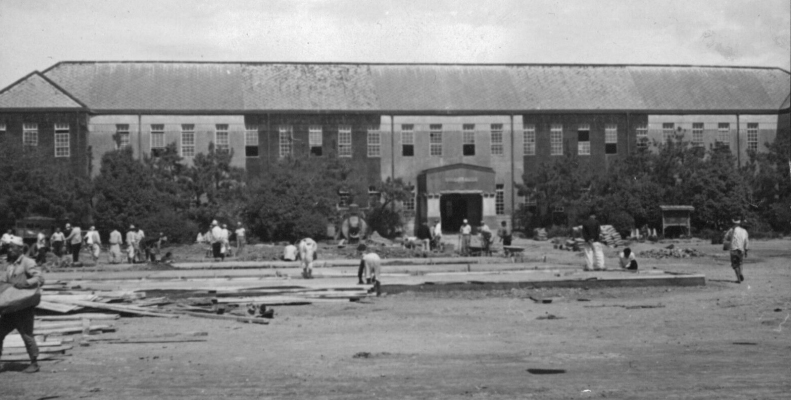
The Swedish Red Cross in Korea
Two days after North Korea attacked South Korea on June 25, 1950, the UN Security Council adopted a resolution which called member countries to support South Korea. The Kingdom of Sweden typically holds a policy of neutrality, however on July 16th, the Swedish Government decided to send a field hospital consisting of voluntary medical and service staff organized by the Swedish Red Cross. On July 20, 1950, Henrik Beer, Secretary General of the Swedish Red Cross, made an appeal on Swedish radio calling on Swedish men and women with the skill set and courage to sign up for service in the Far East.1 Sweden quickly accepted 176 volunteers from 600 applications. Sweden was the first country to decide to provide humanitarian aid for the Korean War. The first group of 48 personnel left Stockholm on August 26th, 1950. They spent about a month at Ft. Dix, New Jersey, until the entire Swedish Red Cross contingent was fully assembled. Eventually, the group landed in two flights on Sept. 23, 1950 in Pusan, Korea.2 At the time, the fighting was so close, that the Swedes were flown in at night with each person wearing a parachute, just in case they were shot down.
The Swedish Red Cross Hospital (서전병원, 瑞典病院 Seojeon Hospital)
Within days, an empty School was converted into the Swedish Red Cross Field Hospital. Initially, they were within 3 miles of the fighting. Only two days after their arrival, they received their first patients, 68 US soldiers. The demand for medical treatment was so great that the hospital quickly expanded from 200 to 450 beds. The staff worked in 12-hour shifts except for Saturdays when some worked 18-hour shifts, which allowed others an additional 6 hours off-duty. Just a few days before the Swedish field hospital arrived in Pusan, UN forces landed at Inchon, and the UN forces in the Pusan Perimeter broke out and advanced North. Plans were drawn up to relocate the field hospital to Heungnam (흥남) and then Wonsan (원산), north of the 38th parallel. The plans were changed because of the Chinese intervention in the war. The commander of the 8th US Army, under which the Swedish field hospital was assigned, decided to keep the hospital in Pusan and use it as an evacuation hospital, rather than a MASH unit.

Svenska Röda Korsets förtjänstmedalj
There was no specific medal issued by the Swedish government for participation in the Korea War. Those personnel who did participate received a Swedish Red Cross Medal of Merit. In the center of the obverse is the truncated bust of King Gustav V. Beneath the bust is the designer’s name: A. Lindberg. The central motif is surrounded by an encircling border with an inscription reading: “Gustav V, King of Sweden”. On the reverse in the center is the Geneva Cross surrounded by a laurel wreath. Beneath the wreath is the recipient’s name and often a date. The central motif is surrounded by an encircling border with an inscription signifying: “For Merit to the Volunteer Medical Service”. The medal has no hallmarks. The suspension is in the form of a royal crown with “horns”. These medals can be unnamed or undated. Even if the date is in the correct time period, the recipient may have or have not served in Korea.

1954/1996
Kamratförbundets för Svenska Koreaambulansens minnes- och förtjänstkors i silver
Between September 25, 1950, and December 31, 1953, the hospital treated 19,100 UN soldiers, 2,400 Korean soldiers, at least 69 North Korean soldiers and an unknown number of Chinese prisoners of war. According to at least one source, they treated some 1,200 POWs. Many Korean civilians were also treated at the hospital. The number of hospital visitors, in total, was about 225,000 people. Demand was sufficient that they had to expand to 600 beds. They remained based in Pusan during the entire course of the war. During the war, 1,124 Swedish men and women served at the field hospital in Busan. In Sept. 1952, the hospital was permitted by the Eight U.S. Army in Korea (EUSAK) to allocate 125 beds for civilians. The following year, another 40 beds were allocated specifically for the treatment of children.
A stalemate in the fighting, existed between July 1951 and July 1953. The SRCH launched a campaign for the medical care of the civilian populace. In 1954, the Swedish Military Hospital became the Swedish Hospital in Pusan, and became a civilian hospital until April 1957 when it ceased operations. The official policy for the treatment of wounded soldiers had been terminated in 1955. The Swedish hospital was then relocated to Pusan National Marine University (국립부산수산대학교, 國立釜山水産大學校)3, which provided a more substantial space, accommodating up to 750 beds. On April 10, 1957, the Swedish Red Cross Hospital ceased operations. In 1958, a small group of Swedes were retained to assist the Korean Red Cross. More than 1000 Swedish personnel served after the war.
In June 1951, representatives of the Danish, Norwegian, and Swedish medical staffs and the United Nations Korean Reconstruction Agency (UNKRA) held meetings for the establishment of a more permanent hospital. On March 13, 1956, the “Agreement on the Establishment and Operation of the National Medical Center (NMC) 국립중앙의료원의 설립 및 운영에 관한 법률” between UNKRA, the Scandinavian governments of Sweden, Denmark, Norway, and the Republic of Korea was concluded. The total initial investment was 5.33 million in U.S. dollars. On Oct. 2, 1958, the National Medical Center 국립중앙의료원 (國立中央醫療院) held an opening ceremony in Seoul and on Nov. 28 started patient treatment (320 beds). The three Scandinavian countries also agreed to provide an additional 1.5 million USD per year for five years after the hospital’s opening. The Korean government, in turn, agreed to bear the current costs for the hospital’s operation, which included 173,000 Hwan (₩) in its first year.
The National Medical Center, was a teaching hospital with 90 different initial positions being filled by Danish, Norwegian and Swedish doctors and nurses. The hospital was transferred to the Korean Government in 1968 after nearly 150 Swedes had served there. Although the hospital was handed over to the Korean authorities, it received Scandinavian assistance until 1971. You can visit a small museum dedicated to the Scandinavians at the NMC in Eulji-ro, Jung-gu, (central) Seoul. In April 2010, the name of the institution was changed to the National Institute of Medical Sciences 국립의료원이으로.
It is interesting to note that Korea and Sweden did not establish formal diplomatic relations until 1959. Four years later, in July 1963, the Korean Embassy was opened in Sweden, and ten years later, in July 1973, the Swedish Embassy was opened in Korea.
Sweden continues its commitment to South Korea by its participation in the Neutral Nations Supervisory Commission (NNSC). The NNSC was established by the signing of the Armistice Agreement on July 27, 1953, and is focused on maintaining the validity of the Armistice Agreement and promoting transparency and confidence on both sides of the demarcation line.
In Stockholm, Sweden, a memorial, called Restare (meaning “to rest” in Latin), is dedicated to all civilian and military veterans who have taken part in missions abroad. In Korea, to commemorate the Swedish participation during the Korean War, a monument was erected by the Swedish Association of Field Hospital and the Swedish-Korean Society in 1971. It is located at the site where the original Swedish Red Cross Field Hospital was located. That site was later the Pusan Commercial High School and has since become a Lotte Hotel.
Korea’s first buffet restaurant, the Scandinavia Club, was located on the premises of the hospital, but closed in 2012 due to financial difficulties. It was a famous Nordic-style buffet restaurant for decades, but ultimately failed to withstand the trends of the times.

Caption on reverse: The Swedish Korean Hospital has been given a school as its headquarters. Barracks are being built in front.
(Det Svenska Korealasarettet har fått en skola till högkvarter. Framför byggs barracker för.)
Dated 11/10 50.

Numbered with a quantity issued of 2,000, in .999 silver, and hallmarked such. The sculpturer is Thomas Qvarsebo, and issued by The Swedish Korean Ambulance Association “Kamratförbundet Svenska Koreaambulansen”. Diameter 7 cm, weight approx. 278 grams. An award certificate accompanies the medal.
Footnotes:
- In 1947, Henrik Beer (1915-1986) became Secretary General of the Swedish Red Cross and in 1960 was elected Secretary General of the League of Red Cross Societies, a post which he held until his retirement in 1981.
- There are other 1st hand accounts which state that they arrived aboard a ship.
- In 1996, the name of the University was changed to Pukyong National University (國立釜慶大學校).
